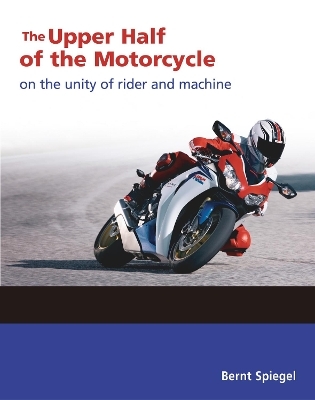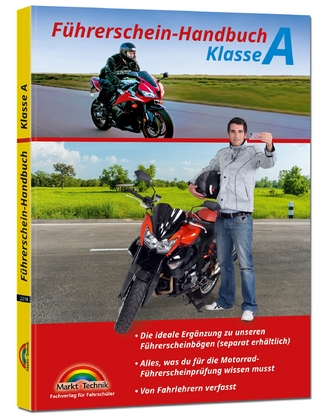
The Upper Half of the Motorcycle
Motorbooks (Verlag)
978-0-7603-6696-7 (ISBN)
- Titel ist leider vergriffen;
keine Neuauflage - Artikel merken
Bernt Spiegel's The Upper Half of the Motorcycle was a best-selling motorcycling book in its original German with multiple editions and printings to its credit. Now translated into English, its provocative message is available to a wider audience. Spiegel's metaphor considers the rider and the motorcycle as a single unit, the rider being the upper half. Taking a multidisciplinary approach, the author draws on anthropology, psychology, biology, physics, and other disciplines to analyze the theory and function of the man-machine unit. Motorcycle riding is seen as a junction where people have created machines for personal transport and then become so adept at using them that the machine becomes like an extension of the rider themself. The ultimate goal for riders is the integration of the man-machine interface and subsequent skill development to the point of virtuosity. Spiegel considers the various aspects of motorcycle riding that must be understood, practiced, and mastered before virtuosity can be attained. Many anecdotes, supplementary material, and in-depth treatment of specialized topics is contained in sidebars and footnotes. Numerous diagrams and photographs illustrate the book's principles allowing the reader to consider and develop their riding skill set.
A behavioral psychologist and university professor, Bernt Spiegel is the senior instructor of Motorrad magazine's Perfection Training program at Nurburgring.
Contents
FOREWORD . . . . . . . . . . . . . . . . . . . . . . . . . . . . . . .xii
PREFACE. . . . . . . . . . . . . . . . . . . . . . . . . . . . . . . . .xv
ACKNOWLEDGMENTS . . . . . . . . . . . . . . . . . . . . . . . . . .xvi
PUBLISHER’S NOTE . . . . . . . . . . . . . . . . . . . . . . . . . . .xix
Part 1
IT’S A MIRACLE THAT MOTORCYCLING WORKS AT ALL!. . . . . . .20
Beginnings . . . . . . . . . . . . . . . . . . . . . . . . . . . . . .20
Our cerebrum, an “aftermarket accessory” (20)
Systems and Subsystems . . . . . . . . . . . . . . . . . . . . . . .20
Is humankind really too dumb? (21)
Our “built-in” speed (22)
When two people do the same thing (22)
Foresight . . . . . . . . . . . . . . . . . . . . . . . . . . . . . . .23
What he doesn’t know can’t frighten him (23)
Maintaining a safe following distance (23)
Our world (24)
Clueless but full of hope (25)
Knowledge and action (26)
Adaptation . . . . . . . . . . . . . . . . . . . . . . . . . . . . . .26
From a young engineer’s report
about his participation in a crash test (26)
On the “center line” (27)
The first liberated creatures (27)
Can’t do without them: programs that control actions (28)
Man, the chameleon (28)
Mixed programs (29)
The great opportunity: acquired programs (30)
Specialists at birth or with practice (31)
Use it or lose it (31)
Action Programs for Motorcycling . . . . . . . . . . . . . . . . . .32
Why nothing feels right when changing motorcycles (33)
Balancing act (35)
Some History . . . . . . . . . . . . . . . . . . . . . . . . . . . . .36
The Physics of Riding 1: How the running bike became a riding bike (37)
The amazing foray into single-track (39)
Was the penny-farthing really such a foolish idea? (39)
Man-Machine Systems . . . . . . . . . . . . . . . . . . . . . . . .40
The development and fine-tuning of action programs (40)
Two subsystems meld into a new system (40)
The man-machine system: a complicated matrix-patrix relationship (41)
Greater than the sum of the parts (41)
Hand training (42)
Inborn Programs . . . . . . . . . . . . . . . . . . . . . . . . . . .43
Flawless actions without conscious “how-to” knowledge (43)
The immovable handlebar (44)
The usefulness of handlebars (45)
The Physics of Riding 2: Motorcycles and children’s scooters, the “skibob” and the “velogemel” (46)
The proof is in the arm muscles (46)
The usefulness of throttles (47)
What Do We Trust?. . . . . . . . . . . . . . . . . . . . . . . . . .49
The power of insight . . . and its uselessness (49)
Part 2
MIND AND GUT . . . . . . . . . . . . . . . . . . . . . . . . . . . . .50
The Workings of the Brain. . . . . . . . . . . . . . . . . . . . . .50
Ancient, but not obsolete (50)
The nitty-gritty on parts of the brain and their functions (51)
A wonderful latecomer (52)
The pros and cons of redundancy (52)
When things get crowded in your head: limited channel capacity—in sensory perception and in actions (53)
Cerebrum and spontaneous action (54)
The conscious self and the subconscious self (54)
Close to, and further from, the self (55)
Depth dimensions of the subconscious self: feelings and moods (55)
The ball toss as a key example (56)
The parable of the centipede (56)
Complex precision movements and successful movement plans (57)
Brain Activities “Translated” into Actions. . . . . . . . . . . . . .58
No movement complex without the movement plan (58)
The ideal line: the razor-sharp divide between confidence and terror (58)
The Nürburgring Nordschleife controversy (59)
Acceleration capabilities and the ideal line (61)
The turn-in point (63)
A postscript on the ideal line: the “racing line” and the “fighting line” (64)
Late turn-ins and the ideal line: a prime example (65)
The actions of the movement plan and their execution (67)
The coaster experiment (68)
Why it’s a good idea to look far ahead (68)
Throwing a ball and riding a motorcycle: closed and open action programs in movement plans (69)
“Decoupling” one’s gaze from a focus on the road (69)
Trigger movement and response movement (70)
Thoughts are forces (70)
Mirror Neurons (70)
Dangers and Risks . . . . . . . . . . . . . . . . . . . . . . . . . . .71
Paying attention without getting involved (72)
Example of a threat that’s hard to visualize (72)
As if riding in a trance (72)
Lying to ourselves: the risk composite (73)
Trust in the Subconscious Self. . . . . . . . . . . . . . . . . . . .73
Riding from memory (73)
A window to the unknown (74)
Self-observation as a disturbance (74)
Attention and conscious awareness as disadvantages (75)
Self-awareness and verbalization as hindrances (75)
The influence of an audience on self-observation (75)
The Arlberg method (75)
Zen in the Art of Archery (76)
Disturbance by self-conscious awareness—does this make any sense? (77)
Case study: the raised beam (79)
The Price We Have to Pay. . . . . . . . . . . . . . . . . . . . . . .82
Creeping blockades (83)
Part 3
THE QUESTION OF KARL V . . . . . . . . . . . . . . . . . . . . . . .84
The Concept of Integration . . . . . . . . . . . . . . . . . . . . . .84
A new unit with a higher level of integration (84)
More than just words and sayings (84)
On merging driver and vehicle (84)
Are tools the exclusive province of human beings? (85)
The motorcycle as tool . . . . . . . . . . . . . . . . . . . . . . . .86
Tool or equipment? (86)
A specified purpose or an end in itself (86)
And the motorcycle? (86)
Man, Objects, and Environment . . . . . . . . . . . . . . . . . . .87
Not environment and not object (87)
But what then? (87)
Using tools to perfection (88)
Interface Displacement . . . . . . . . . . . . . . . . . . . . . . . .88
Artificial and functional organs (88)
Technology of tools (88)
Things we can put down or swap (89)
Tools as organ replacements (89)
The division between function fulfillment and the control of that function (90)
Integration and Super-ordinate Systems. . . . . . . . . . . . . . .90
Artificial organs and integrated artificial organs (90)
Just like using a prosthesis (91)
Interface is not the same as point of contact (92)
Classic craftsman’s tools (92)
The dangers of dis-integration (93)
Orchestras, flocks, and fish (93)
Sensing without sensors? (94)
How vision works (94)
Transfer to the tactile (94)
Dis-integration in racing (94)
Separation of the experienced interface from the physical interface (95)
Rainey’s constant reminder (and two other witnesses) (95)
Hass’s concepts: supplemental organs; extra-physical organs (95)
Dilution of the “integration” concept (95)
Integration in Motorcycling . . . . . . . . . . . . . . . . . . . . .96
Static friction and sliding friction (96)
Distinct evidence experiences (97)
The protective nature of evidence experiences (97)
The impossibility of riding a motorcycle fast without interface displacement (98)
The limits of slide (98)
Kamm’s Circle (99)
Bowl and marble: a model (99)
The Transition to Integration. . . . . . . . . . . . . . . . . . . .102
An equestrian example (103)
Getting into the ride (103)
The influence of mental preparation on reaction time (104)
“Slipping in,” all the way to the edges of the vehicle (104)
Reaction time in territorial animals (104)
Taking surroundings into account (105)
The phenomenon of “mysterious message” transmission (105)
The Effects of the Deep, Subconscious Self on Integration. . . .106
Training progress and hitting the plateau (106)
A different kind of judgment (106)
Minimally fatiguing riding (106)
Flow, simultaneously helper and enemy (107)
“Built-in” parts and self-observation (109)
Part 4
WHAT’S LEFT FOR THE HEAD TO DO?. . . . . . . . . . . . . . . . .110
Tasks for the Conscious Self. . . . . . . . . . . . . . . . . . . . .110
A very long list! (110)
Defense against external dangers: forming hypotheses (110)
Self-Perception . . . . . . . . . . . . . . . . . . . . . . . . . . . .112
Realistic perception of oneself, required (112)
Market psychology and buyer perception (112)
The lean angle and its limits (113)
Hanging off (114)
Parts and attendant dangers (115)
Monitoring the self-image (116)
Monitoring the attitude toward risk (116)
Monitoring flow (116)
Everything that relates to planning (116)
Training, oriented toward the future (117)
Training as correction (117)
The danger of relapse (117)
Training intent (117)
Monitoring of hypothesis construction (118)
Objective self-criticism and object criticism (118)
The farmer’s swim trunks (118)
Becoming able to be self-critical (119)
Training Aids. . . . . . . . . . . . . . . . . . . . . . . . . . . . .119
Mental Training. . . . . . . . . . . . . . . . . . . . . . . . . . .121
A caveat (121)
Basic goals of mental training (122)
“Mental” in the context of motorcycle training (122)
Motivation and attitude (124)
“Over-relaxation”: a case in point (124)
Relaxation “chains” (124)
Vagotonal economy and the parasympathetic system (125)
A disinterested spectator or an actively involved participant (126)
Mental simulation: “dry run” training (126)
Specific Acts of Mental Training. . . . . . . . . . . . . . . . . .127
Interface displacement (127)
Mental preparation of complete action programs (128)
Watching for possible escape routes (129)
Sensitization (129)
Finding the gaps! (130)
Mentally preparing to evade an accident (131)
Keeping action programs at the ready: escapes offroad (132)
Figure-ground reversible images (132)
Mentally preparing to increase the lean angle (133)
The limitations of training in real situations (133)
Combating the enemy: fear (134)
“Tension release in seconds” method (135)
Conceptual Aids . . . . . . . . . . . . . . . . . . . . . . . . . . .136
Preparatory and accompanying conceptual aids (137)
Examples of conceptual aids (137)
Plateaus and leaps forward (137)
Developing your own conceptual aids (138)
Training Objectives. . . . . . . . . . . . . . . . . . . . . . . . .138
Keeping objectives at the forefront (140)
Objectives in the form of preemptive corrections: reminder stickers (140)
Use of reminder stickers in training courses (140)
Overcoming ingrained behaviors and actions that are undesirable (142)
Refreshing one’s objectives (142)
Calling up a complicated objective using keywords (143)
Part 5
OBJECTIVES: GIVE THEM A TRY. . . . . . . . . . . . . . . . . . . .144
Looseness . . . . . . . . . . . . . . . . . . . . . . . . . . . . . .144
The “play face” (146)
When it rains: rules for wet, slippery conditions (147)
Rider and Road . . . . . . . . . . . . . . . . . . . . . . . . . . .150
Hard-packed snow slipperiness (150)
The inborn hindrance to looking far ahead (151)
Riding Posture . . . . . . . . . . . . . . . . . . . . . . . . . . . .154
Rolling resistance and stabilization gas (154)
Objectives for Practice . . . . . . . . . . . . . . . . . . . . . . . .158
Applying the front brake hard
and briefly until the wheel locks
(maximum: 0.1 second) (158)
General Practice . . . . . . . . . . . . . . . . . . . . . . . . . . .159
Escape offroad (160)
Epilogue
THE FASCINATION OF MOTORCYCLING. . . . . . . . . . . . . . . .162
GLOSSARY. . . . . . . . . . . . . . . . . . . . . . . . . . . . . . .164
REFERENCES . . . . . . . . . . . . . . . . . . . . . . . . . . . . . .175
ABOUT THE AUTHOR . . . . . . . . . . . . . . . . . . . . . . . . . .189
| Erscheinungsdatum | 31.07.2019 |
|---|---|
| Zusatzinfo | 150 color photos |
| Sprache | englisch |
| Maße | 210 x 267 mm |
| Themenwelt | Natur / Technik ► Fahrzeuge / Flugzeuge / Schiffe ► Auto / Motorrad |
| ISBN-10 | 0-7603-6696-9 / 0760366969 |
| ISBN-13 | 978-0-7603-6696-7 / 9780760366967 |
| Zustand | Neuware |
| Haben Sie eine Frage zum Produkt? |
aus dem Bereich


